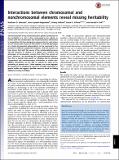| dc.contributor.author | Edwards, Matthew Douglas | |
| dc.contributor.author | Gifford, David K. | |
| dc.contributor.author | Symbor-Nagrabska, Anna | |
| dc.contributor.author | Dollard, Lindsey | |
| dc.contributor.author | Fink, Gerald R. | |
| dc.date.accessioned | 2014-12-01T15:10:24Z | |
| dc.date.available | 2014-12-01T15:10:24Z | |
| dc.date.issued | 2014-05 | |
| dc.date.submitted | 2014-02 | |
| dc.identifier.issn | 0027-8424 | |
| dc.identifier.issn | 1091-6490 | |
| dc.identifier.uri | http://hdl.handle.net/1721.1/91949 | |
| dc.description.abstract | The measurement of any nonchromosomal genetic contribution to the heritability of a trait is often confounded by the inability to control both the chromosomal and nonchromosomal information in a population. We have designed a unique system in yeast where we can control both sources of information so that the phenotype of a single chromosomal polymorphism can be measured in the presence of different cytoplasmic elements. With this system, we have shown that both the source of the mitochondrial genome and the presence or absence of a dsRNA virus influence the phenotype of chromosomal variants that affect the growth of yeast. Moreover, by considering this nonchromosomal information that is passed from parent to offspring and by allowing chromosomal and nonchromosomal information to exhibit nonadditive interactions, we are able to account for much of the heritability of growth traits. Taken together, our results highlight the importance of including all sources of heritable information in genetic studies and suggest a possible avenue of attack for finding additional missing heritability. | en_US |
| dc.description.sponsorship | National Science Foundation (U.S.). Graduate Research Fellowship Program (Grant 0645960) | en_US |
| dc.description.sponsorship | Qatar Computing Research Institute | en_US |
| dc.language.iso | en_US | |
| dc.publisher | National Academy of Sciences (U.S.) | en_US |
| dc.relation.isversionof | http://dx.doi.org/10.1073/pnas.1407126111 | en_US |
| dc.rights | Article is made available in accordance with the publisher's policy and may be subject to US copyright law. Please refer to the publisher's site for terms of use. | en_US |
| dc.source | National Academy of Sciences (U.S.) | en_US |
| dc.title | Interactions between chromosomal and nonchromosomal elements reveal missing heritability | en_US |
| dc.type | Article | en_US |
| dc.identifier.citation | Edwards, M. D., A. Symbor-Nagrabska, L. Dollard, D. K. Gifford, and G. R. Fink. “Interactions Between Chromosomal and Nonchromosomal Elements Reveal Missing Heritability.” Proceedings of the National Academy of Sciences 111, no. 21 (May 13, 2014): 7719–7722. © National Academy of Sciences | en_US |
| dc.contributor.department | Massachusetts Institute of Technology. Computer Science and Artificial Intelligence Laboratory | en_US |
| dc.contributor.department | Massachusetts Institute of Technology. Department of Electrical Engineering and Computer Science | en_US |
| dc.contributor.department | Whitehead Institute for Biomedical Research | en_US |
| dc.contributor.mitauthor | Edwards, Matthew Douglas | en_US |
| dc.contributor.mitauthor | Gifford, David K. | en_US |
| dc.relation.journal | Proceedings of the National Academy of Sciences of the United States of America | en_US |
| dc.eprint.version | Final published version | en_US |
| dc.type.uri | http://purl.org/eprint/type/JournalArticle | en_US |
| eprint.status | http://purl.org/eprint/status/PeerReviewed | en_US |
| dspace.orderedauthors | Edwards, Matthew D.; Symbor-Nagrabska, Anna; Dollard, Lindsey; Gifford, Daniel K.; Fink, Gerald R. | en_US |
| dc.identifier.orcid | https://orcid.org/0000-0002-5845-748X | |
| dc.identifier.orcid | https://orcid.org/0000-0003-1709-4034 | |
| mit.license | PUBLISHER_POLICY | en_US |
| mit.metadata.status | Complete | |
